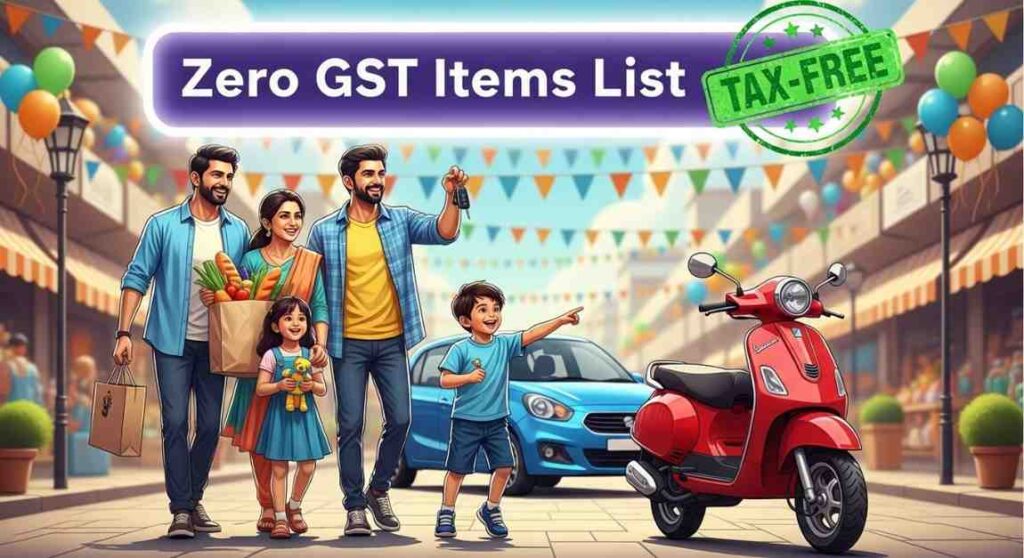
When the new tax changes rolled in, the most buzzing question among families was simple: what exactly comes under the Zero GST items list? Because this move has not only made kitchen goods cheaper, but also slashed the price of two-wheelers, cars, and even household appliances. The savings are so visible that a middle-class family can actually feel the difference in their monthly budget.
Daily Essentials Under Zero GST items list
Earlier, even the most basic food and household items carried 5 to 18 percent GST. Now, with the updated Zero GST items list, staples like roti, paneer, khakhra, and several dairy products have become tax-free. This is a big relief because milk, ghee, cheese, and butter are products every home consumes regularly. For a household that buys these in bulk every month, the difference directly translates to ₹800–₹1000 extra savings without any effort.
Packaged Foods and Personal Care Get Cheaper
It’s not just kitchen essentials—packaged foods that earlier fell under the 12 to 18 percent GST bracket have now shifted down to 5 percent. Biscuits, instant noodles, chocolates, ready-to-eat meals, and pasta are all cheaper. Even shampoos, face washes, toothpaste, and hair oils, which once carried heavy tax, are now under the lower slab. Families using these every month can expect close to ₹10,000 to ₹12,000 yearly savings, just from these categories.
Insurance Becomes Tax-Free for the First Time
One of the biggest announcements hidden in the Zero GST items list is insurance. Until recently, both health and life insurance premiums carried 18 percent GST. Now, they are completely GST-free. This is a huge win for families because insurance is not a luxury—it’s a necessity. A basic life cover or a ₹10 lakh health insurance policy now comes significantly cheaper, encouraging more people to secure their families without feeling overburdened by taxes.
Cars and Bikes See Massive Price Drops
Vehicles have seen jaw-dropping reductions in ex-showroom prices thanks to lower GST. Popular two-wheelers like Honda Activa and Splendor now cost around ₹7,000–₹8,000 less. Bajaj Pulsar and TVS Apache buyers are saving between ₹14,000–₹15,000. Even premium bikes such as Suzuki SF250 are cheaper by over ₹15,000.
On the car side, Maruti Alto K10 is down by nearly ₹1 lakh, while other bestsellers like Swift, Dzire, Grand i10, Hyundai i20, Tata Tiago, and Tata Punch are all seeing savings between ₹50,000 to ₹85,000. For middle-class buyers, this drop in prices is nothing short of a festive gift.

Household Appliances Also Affected
The Zero GST items list has had an indirect impact on household upgrades as well. Large appliances like refrigerators, air conditioners, washing machines, and televisions are now cheaper by several thousand rupees each. While these are not everyday purchases, even a one-time saving of ₹15,000–₹20,000 matters when planning a major upgrade.
What About Gold?
Interestingly, gold buyers won’t see any relief. Gold still attracts 3 percent GST on the metal value and 5 percent on making charges. So while household items, insurance, and vehicles have become affordable, jewelry prices remain unchanged.
Final Word: Use Your Savings Wisely
With the Zero GST items list benefiting both daily budgets and one-time purchases, families can expect yearly savings of ₹20,000 or more. Instead of spending this extra money casually, it makes sense to invest it in SIPs, fixed deposits, or upgrading insurance plans. After all, today’s small savings can become tomorrow’s wealth if directed smartly.
Madhya Pradesh Police Constable Recruitment 2025 – Check Vacancy, Eligibility, Salary and Exam Date